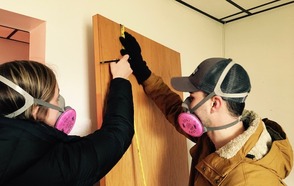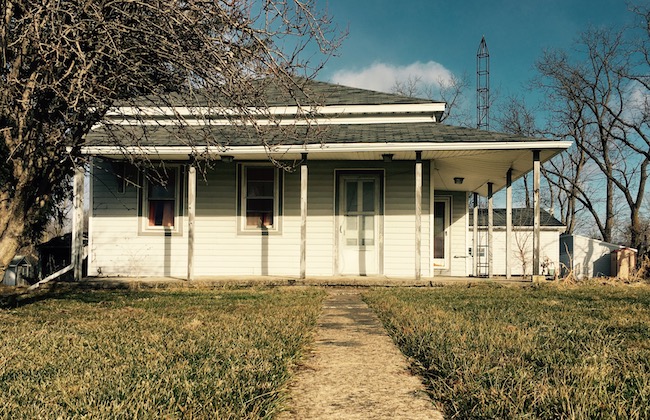(Un)Building a House

January 6, 2017
It’s an hour into Winter Term, and students are already combing through a condemned house on the outskirts of Greencastle. With the heat turned off, it’s nearly as cold inside as it is in the freezing January air outdoors. Students bundled in winter gear and respirator masks – leaks in the roof fed a bad mold infestation – navigate cramped, dark corners of the house, which looks more like something out of a horror flick than the setting for a college class.
A building in this condition would normally be written off as a total loss and torn down. In fact, this one will be, too – but with a twist. Instead of demolishing the building and hauling the rubble to landfills or incinerators, students are working alongside faculty, staff and community members to reuse or recycle as much of the house as they can. Sandwiched between bulging ceiling panels and damp carpets, the students group up, moving through each room to catalog what remains.
Course leaders Jennifer J. Everett, an associate professor of philosophy and co-director of the Environmental Fellows Program, and energy engineer Chris D. Hoffa originally planned to use this Winter Term to renovate the house, which had been used as a base camp for the Campus Farm. That all fell through when inspections uncovered the mold and structural issues with the foundation. Instead, the course pivoted from construction to deconstruction. The goal for students now: figure out how to tear down the home with the smallest environmental impact.

Everett says the economics involved in this kind of project don’t always make that easy. “Most materials and structures haven’t been designed for deconstruction and reuse, so instead of reusable lumber, you might find a lot of particleboard or plywood full of adhesives,” she explains. “There may be recycling markets for these materials, although like glass recycling, it may be cost prohibitive just to get the materials to those markets."
But even that knowledge is useful, Everett argues, whether for an architect planning for the entire lifecycle of a building, or a college student learning the bigger picture of what it means to build a home.
“For us, even if the financial opportunities of deconstruction are few, the educational opportunities are extremely plentiful,” Everett says.
In addition to the deconstruction aspect of the course, students are also being exposed to outside perspectives on the life of materials, with guest lectures from arts and humanities professors as well as recycling and building deconstruction professionals.
“The thing I most want students to take away from this course is an embodied understanding that they have the power to make real change in the world, right now,” Everett says. “Nothing stands between them and the work of making the world a better, more sensible, more caring, more mindful place – starting here, at DePauw, with this house.”
Back